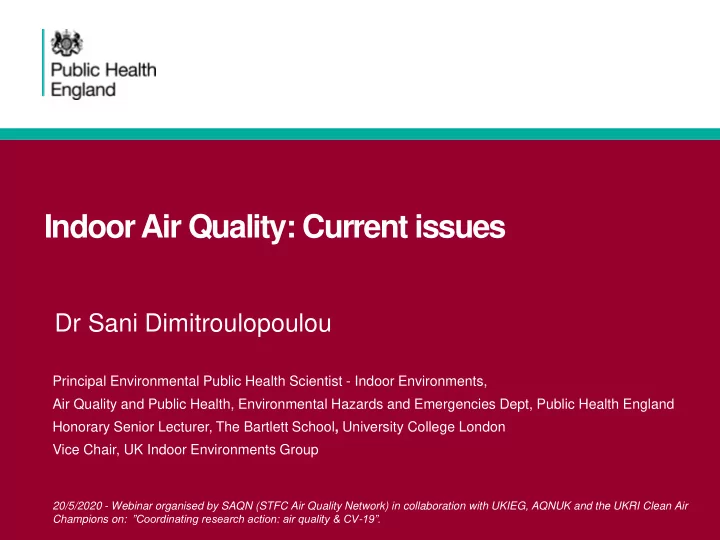

Indoor Air Quality: Current issues Dr Sani Dimitroulopoulou Principal Environmental Public Health Scientist - Indoor Environments, Air Quality and Public Health, Environmental Hazards and Emergencies Dept, Public Health England Honorary Senior Lecturer, The Bartlett School , University College London Vice Chair, UK Indoor Environments Group 20/5/2020 - Webinar organised by SAQN (STFC Air Quality Network) in collaboration with UKIEG, AQNUK and the UKRI Clean Air Champions on: ”Coordinating research action: air quality & CV - 19”.
Factors affecting IAQ Ventilation Occupant activities
Pollutants emitted from indoor sources Indoor pollutants RCP (2016); RCPCH / RCP (2020)
PHE IAQ activities PHE ➢ PHE IAQ guidelines for selected VOCs ➢ Impact of home air purifiers on IAQ and health ➢ CO 2 : an indicator or a pollutant? Government ➢ Cross Government Group On Gas Safety And Carbon Monoxide Awareness / All Fuels Action Forum / on-going ➢ MHCLG Revision of Building Regulations (Part L and Part F) ➢ Government Review into CO Alarm Requirements (England) ➢ CMO Cross Gov meeting on IAQ: Setting the scene (Feb 2020) Other Organisations ➢ CIBSE TM40: Health Issues in Building Services (2020) ➢ NICE guidelines / standard on indoor air quality at home (PHE co-badged, 2019) ➢ RCP and RCPCH Systematic Review: “Effects of Indoor Air Quality on Children and Young People’s Health” (2020) ➢ WHO Experts Group on IAQ and children’s health
RCPCH and RCP Effects of indoor air quality on children and young people’s health Research project Produced an evidence- based report on the impact of indoor air pollution RCPCH (2020) https://www.rcpch.ac.uk/sites/default/files/2020-01/the-inside-story-report_january-2020.pdf
Presentation title - edit in Header and Footer
IAQ and COVID-19 ▪ We are actively reviewing evidence on indoor air and COVID-19 to inform PHE’s guidance and advice. ▪ Currently attention is being paid on how COVID-19 is transmitted indoors and how building services should operate to prevent the spread. Current evidence: Coronaviruses are quite resistant to environmental changes and become inactive only to very high relative humidities above 80% and temperatures above 30 ˚C (Casanova et al., 2010; Doremalen et al., 2013). Therefore, at typical UK indoor temperatures of 21-23 ℃ and relative humidity of 40-65%, coronaviruses may show stability.
IAQ and COVID-19 Otter et al., 2016. https://www .ncbi.nlm.nih.gov/pubmed/26597631
Guidance on buildings https://www.rehva.eu/activities/covid-19-guidance https://www.cibse.org/coronavirus- covid-19/coronavirus-covid-19-and- hvac-systems http://www.bco.org.uk/Research/Publications/Though ts_on_Office_Design_and_Operation_After_Covid- 19.aspx
Let’s work together to reduce our exposure to indoor air pollution Thank you! www.gov.uk/phe Sani.Dimitroulopoulou@phe.gov.uk
Recommend
More recommend